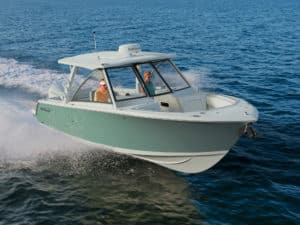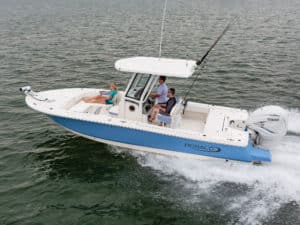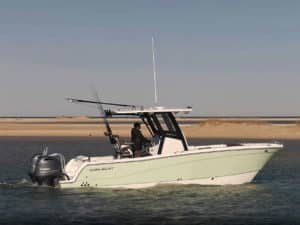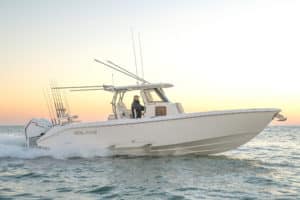The palm fronds barely rustled as a light breeze rippled the canal that led to the launch ramp at Florida’s Homestead Bayfront Park. “We just might catch a break in the weather,” I said to Capt. Jon Cooper, as we launched the new Contender 22 Sport for a morning of fishing off the upper Keys in late January.
“I hope we catch more than that,” piped in Jordan DeLong, project manager for Contender Boats, who joined us for this Fish Trial.
Unfortunately, a forecast calling for 25-knot winds, seas to 4 feet, and scattered showers meant this lull was simply the calm before the storm. We loaded three-dozen shrimp from the waterfront bait shop in the pressurized 26-gallon transom livewell and headed out. We planned to target hogfish along the patch reefs outside John Pennekamp Coral Reef State Park, and Cooper was determined to get it done early.
“Let’s get out there before the wind starts to howl,” he said, as we exited the no-wake zone under clear skies and accelerated on a southeast heading toward the cut at Angelfish Creek.
Powered by a Yamaha F250 outboard, the 22 Sport streaked across the light chop at about 40 mph and 4,000 rpm, bringing a wind-swept smile to my face. I was pleased that Contender continues to nurture the smaller end of the fish-boat spectrum. In fact, this boat is the smallest in the builder’s current lineup, which reaches up to 40 feet in length.
“The 22 Sport was designed to be a starter boat for those in their mid-20s to 30s,” said DeLong, as we idled back to traverse a manatee zone. “It’s for someone who has always wanted a Contender but couldn’t quite swing it financially before this.”
Family-Friendly
If you want to take the family, the 22 Sport offers plenty of seats, including a pair in the stern quarters, one on the front of the center console, and two elevated pods with snap-on upholstery and a filler cushion forward that creates U-shaped seating in the bow.
Padded coaming bolsters wrap around the bow and transom areas to also serve as backrests, but you can order taller backrests for the two aft seats. A step-down console interior — accessible via a door on the starboard side — offers 5 feet, 4 inches of headroom for changing into a swimsuit. There’s space for a portable marine toilet or you can order an optional permanent marine head.
For swimming and diving, the 22 Sport features a pair of transom swim platforms — one on either side of the splash well — with a walkway between just abaft the transom bulkhead. A pullout swim ladder on the starboard side lets you easily climb back aboard.
Reef Recon
Outside the cut, I weaved through a virtual minefield of crab-pot buoys, a job made easier with the U-Flex hydraulic steering. My tester also featured Yamaha digital throttle and shift and a Yamaha Command Link+ display.
This Contender did not yet have electronics, but the 31-inch-wide helm panel will accommodate a 16-inch multifunction display. A special visor atop the panel helps reduce glare on your electronics. Cooper used a tablet with the Navionics Boating app to home in on his favorite reef. The clear water allowed him to eyeball the reef and anchor upwind of it to fish.
The anchor locker on the 22 Sport has copious room for line and a pipe to contain the shank of the anchor. There’s an integral bracket on the inner rim of the locker in which the crossbars of a Danforth-style anchor can nest. A pullup cleat under the hatch offers a place to tie off.
There was plenty of room for three of us to fish across the stern as we cast live shrimp back into the current. It took a while for the fish to start biting, so I used the downtime to explore other features.
Built to Fish
The relatively flat sheer line contains not a single element to snag a fishing line or cast net. An anodized-aluminum grab rail wraps from amidships around the bow to enhance safety, but it is recessed and unobtrusive. The stainless-steel bow fixture for the red/green running lights folds flat during daylight hours. All cleats push down when not needed.
A 94-gallon fish locker resides under the foredeck, and two 30-gallon fish boxes flank the aft cockpit sole. A central hatch in the aft cockpit offers access to the bilge rigging, with the batteries under the seats in each stern quarter. You’ll also find a 95-gallon dry-storage compartment under each elevated forward seating pod. All hatches are gasketed and guttered to channel away water, and deck hatches feature compression latches.
When not fishing, we stowed our rods in a four-rod vertical rack along the port side of the pod-style center console, as well as in a three-rod rack on the backside of the leaning post. A slightly larger leaning post is also available as an option. Both models let you secure a Frigid Rigid cooler underneath. Two gunwale rod holders on each side of the boat are ideal for trolling.
Nineteen-inch walkways beside the console allow you to easily fight a fish down the rail. Our boat was equipped with a canvas T-top and an anodized-aluminum frame, which provided a great place to hold on while underway.
Hogfish Heaven
By the end of my inspection, both the wind and fishing began to accelerate. As whitecapping waves out of the south grew, DeLong set the hook on a fish. He immediately proclaimed, “Right kind!” Sure enough, it was a hogfish. No sooner had we iced that fish than Cooper also hooked up and landed another hog. Then DeLong scored again.
All the while, Cooper kept an eye on the sea conditions. As the front approached, winds blew steady at 25 mph with gusts to 30. Yet I felt safe and secure in this 22½-footer, which also remained stable even when all three of us gathered along the 24-inch-high gunwale in the aft cockpit. The grit-style nonskid provided great traction. With a self-bailing deck, the boat can quickly drain any green water.
Despite the gale, we continued to fish. The decision paid off with yet a fourth hogfish. We iced the fish and washed the slime from the deck using the raw-water coil hose, but minutes later the sky darkened and distant sheets of rain blurred the horizon. Time to go.
With the anchor up, I put the 22 Sport on a course for Angelfish Creek. As the menacing seas assaulted the port beam, the boat ran surprisingly dry at about 4,000 rpm and 33 mph. With 22.5 degrees of deadrise at the transom, the hull knifed smoothly through waves.
Sport-Worthy
I gathered performance in protected waters. With 40 gallons of fuel on board and turning a 13¾-by-19-inch Yamaha Reliance three-blade stainless-steel propeller, the Contender jumped on plane in 4.2 seconds and accelerated to 30 mph in 8 seconds.
Top speed was an eye-watering 55.5 mph at 5,900 rpm, where the Yamaha F250 burned 24.5 gallons per hour for a thrifty 2.26 mpg. Yet the most economical cruising speed came at 4,500 rpm and 41.5 mph where the F250 sipped just 14.4 gallons per hour for 2.88 mpg and a maximum cruising range of 288 miles based on the 100-gallon fuel capacity.
As we wrapped up the testing, the rain closed in, but I utilized the 22 Sport’s speed to outrun the squall. Back in the harbor, I asked Capt. Cooper what he thought of the boat. “It’s the perfect boat for the Florida Keys,” he said. “You can fish both sides, getting in shallow (18 inches with the motor up) for inshore fishing, and then pick your days and go offshore.
“If I had a place in the Keys, I’d have two boats — a big one and this one.”
In this era of supersize center-consoles, I find it heartening that boatbuilders see a place in the market for smaller models that are easy on the wallet yet can handle rough weather. If you’re looking for your first boat or a compact second boat, the 22 Sport is a worthy Contender.
PERFORMANCE
POWER: Single Yamaha F250
LOAD: 40 gal. fuel, three crew
TOP SPEED: 55.5 mph @ 5,900 rpm
TIME TO 30 MPH: 8 sec.
BEST MPG: 2.88 @ 41.5 mph (4,500 rpm)
HULL
LOA: 22 ft. 6 in
BEAM: 8 ft. 6 in.
DEADRISE: 22.5 deg.
WEIGHT (ready to fish): 4,450 lb.
DRAFT: 1 ft. 6 in. (motor up)
FUEL: 100 gal.
MAX POWER: 300 hp
PRICE AS TESTED: $86,177 with Yamaha F250
Homestead, Florida
800-645-2906
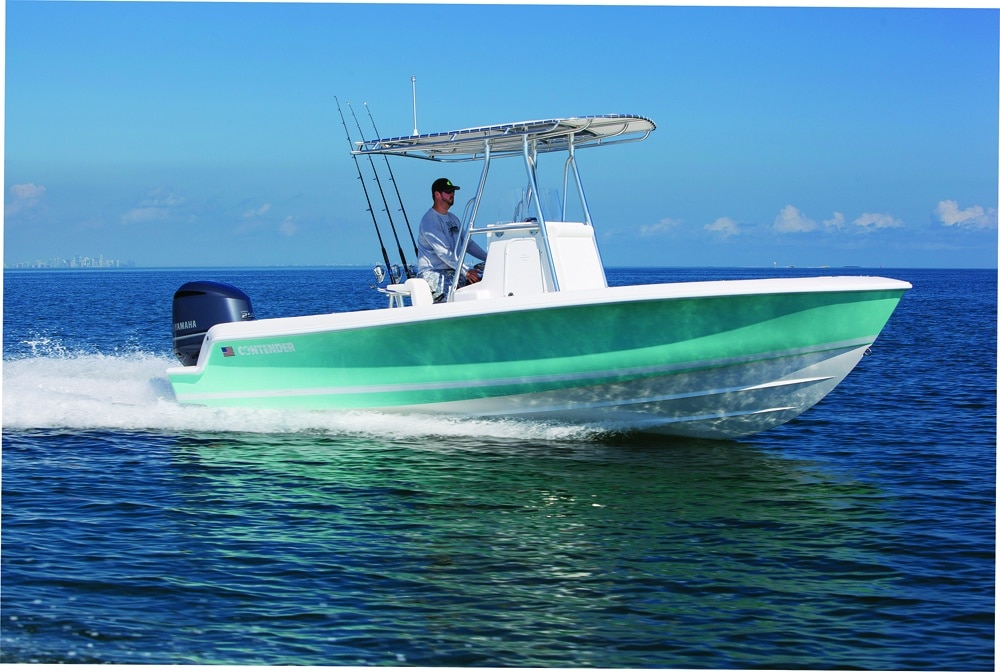
Smooth Operator
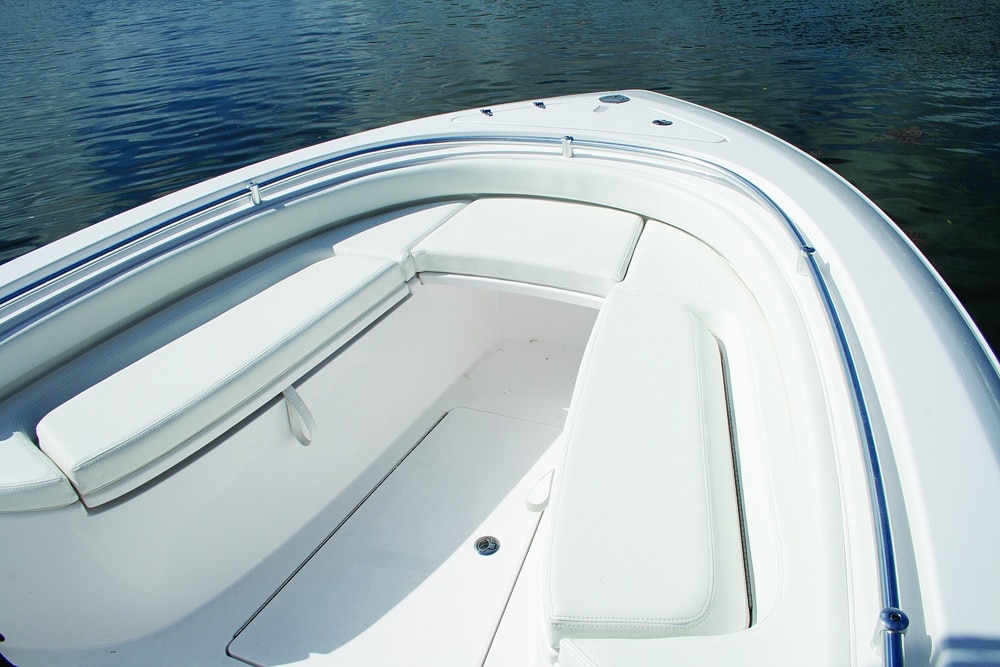
Creature Comfort

Anchor Station
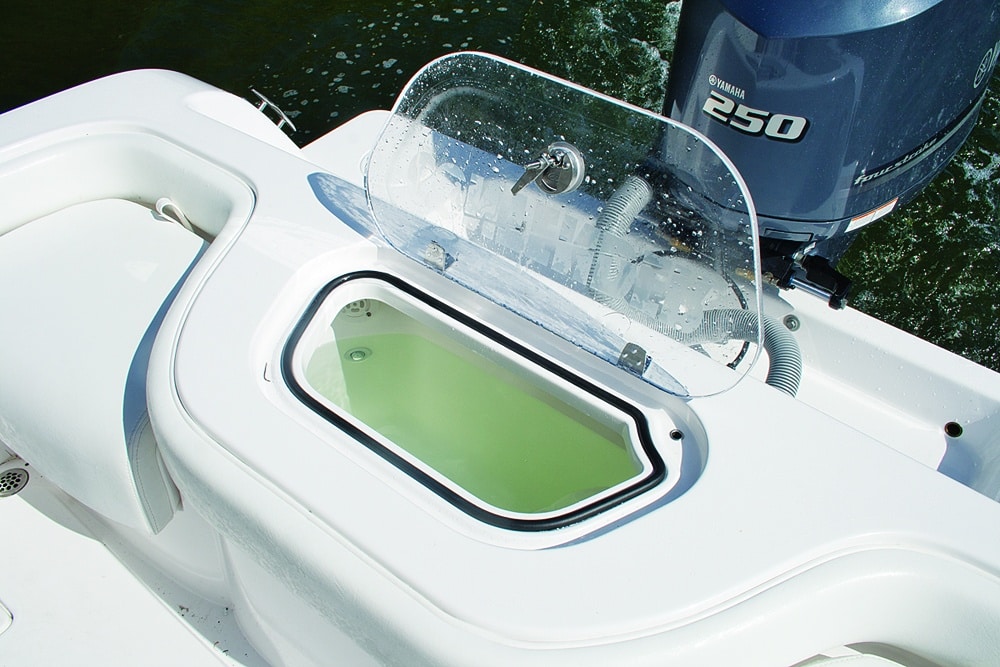
Big Livewell
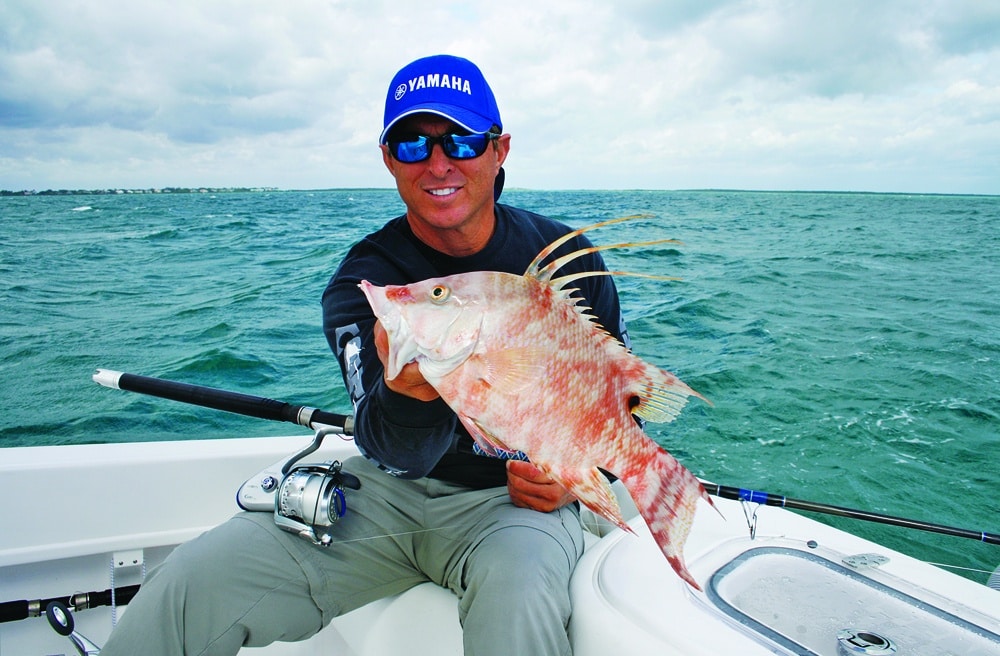
Hog Heaven


